(i) State-level development Zone-Shihezi Economic Development Zone
Established with the approval from the People's Government of Xinjiang Uygur Autonomous Region in 1992, established as a state-level development zone with the approval from the State Council in 2000, Shihezi Economic Development Zone is an important zone supported by the autonomous region and XPCC, hosting many famous brand enterprises such as Taiwan Master Kong instant food, Tingjin Drinks, Bingxin Paper, Wang Wang Food, Wahaha drink, Xiongfeng Cotton Textile, Hisun Weaving, Jiangsu Yurun Meat Products, Xinjiang Tianye Group. It is one of the development zones developing at the highest speed, attracting the largest amount of foreign capital, gathering the largest group of famous domestic and international enterprises in Xinjiang.
In 2005, this zone had a total output value of 2.05 billion yuan; in-place funds through foreign investment promotion and capital attraction of 2 billion yuan. At present this zone hosts 550 domestic and international enterprises including 60 key industrial enterprises, each of which has an annual production of 5 million yuan or more, 17 enterprises of which has an annual productivity of over 100 million Yuan, 24 enterprises of which has an annual productivity of over 10 million yuan, initially forming an industrial group with high interrelatedness and strong matching ability.
In the new development, Shihezi Development Zone will depend on resource superiorities, vigorously expand and develop the four important industries of cotton textile, green food, modern agricultural equipment and heavy chemicals, develop new & high-tech industry and high added value service industry, build itself into a technologically advanced environmentally fine comprehensive industrial zone.
(ii) Newly Built Cities Shihezi City
Established in February 1950, with a total area of 7,529 square kilometers, a total population of 569,600, Shihezi City has an urban area of 460 square kilometers, an urban population of 250,000. During the past 56 years, Shihezi Reclamation Area has become a new type oasis taking the modernized agriculture as foundation, the light industry as main body, combination of industry and agriculture, urban area and rural area, comprehensive operation of agriculture, industry, commerce, trade and garment, coordinated development of science, technology, education, culture, health and sports. Premier Zhou Enlai Memorial Hall, Army Wasteland Reclamation Museum and
Ai Qing Poetry Hall have made it famous land reclamation city. Shihezi City has transport facilities, advanced communication, with Eurasia continent bridge and No.312 National Highway crossing from it respectively in the north and south. In the 21st century, Shihezi City will keep its great reputation, and make more achievements in various circles.
Alaer City
Located at the source of the Tarim River, intersection of juncture of the Hotan River, the Yeerqiang River and the Aksu River, on the south foot of Tianshan Mountain, with an urban area of 4,196 square kilometers, constructed urban area of 33 square kilometers, and a total population of 240,000, Alaer is especially famous for cotton with an annual production of ginned cotton of 230,000 tons, long-staple cotton export amount covering 70% of the total amount of China, hosts the 3 listed companies of Xinjiang Tarim Agricultural Comprehensive Development Co., Ltd., Xinjiang Qingsong Building Materials and Chemicals (Group) Co., Ltd. and Xinjiang Tarim River Seeding Co., Ltd., China's only long-staple cotton breeding center and agricultural science research institute, and China's largest long-staple cotton production center as well as transformation and value-adding demonstration center of Xinjiang characteristic agricultural and subsidiary products.
City positioning: cotton textile city, agricultural and subsidiary product production and processing collection and distribution city, green ecological sightseeing city, wasteland reclamation cultural city, South Xinjiang petrochemical processing city.
Tumshuq City
Located at the northwestern edge of Tarim Basin, Xinjiang, with a total area of 1,901 square kilometers, an urban planned area of 92.7 square kilometers, a total population of 150,000. It has now a cultivated area of 1,100,000 mu, land resources to be used of 750,000 mu, rich primary diversiform-leaved poplar forests, Xinjiang poplar, natural pastures, wild licorice, bluish dogbane and bitter bean of 1,200,000 mu of very high economic development value.
Tumshuq City has the largest plain reservoir in the Northwest, namely, Xiaohaizi Reservoir, and Yonganba Reservoir with a storage capacity of 700 million cubic meters, useable water surface of 155 square kilometers. Tumshuq City borders Kyrgyzstan, Tajikistan, Uzbekistan, Pakistan and Afghanistan, has 4 first or second category trading ports, Kashi International Airport, South Xinjiang Railway, No.314 National Highway and other channels, enjoying transport facilities.
Key industrial development orientation: cotton textile, food, building materials, electric power energy, tourism and other industries.
Wujiaqu City
Located at northern suburbs of Urumqi City, borders Changji City, Miquan City, Fukang City, with an urban area of 710 square kilometers and a population of 116,000. It has now a cultivated area of 2,580,000 mu, pastures of 5,490,000 mu, forest land of 300,000 mu, waters of 410,000 mu, 17 reservoirs or lakes, adoptable ground water amount of 540 million cubic meters.
Wujiaqu City has a bright mineral resource development prospect, 15 coal mines with a total reserve of 295 million tons, out of which the coal and coke center of Dahuangshan Coal Mine has an annual coal and coke production of 3 million tons and 700,000 tons respectively, salt pond geological reserve of 9,828,000 tons, mirabilite reserves of 2.62 million tons, pyrophyllite reserve of 1.5 million tons, and other minerals such as chromite, quartz sand and pearlite. It has Qingeda Lake Scenic Spot, Xiaxing Lake, Fengqi Lake, Aquatic Paradise and other tourist resources, with lake and mountain scenery complementing wild animals and plants and forming unique oasis scenery.
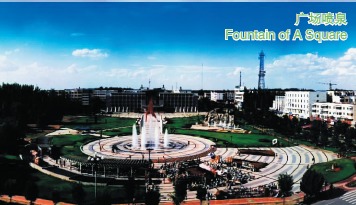
City positioning: a garden ecological city and modern satellite city within Urumqi city circle.
Development Zones and Newly Built Cities
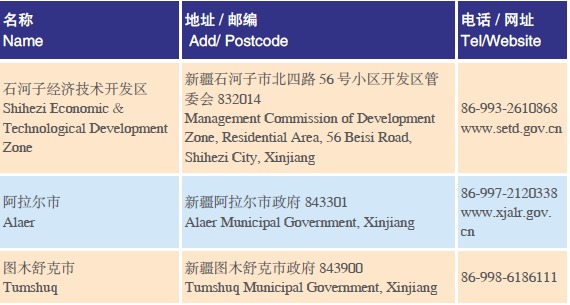
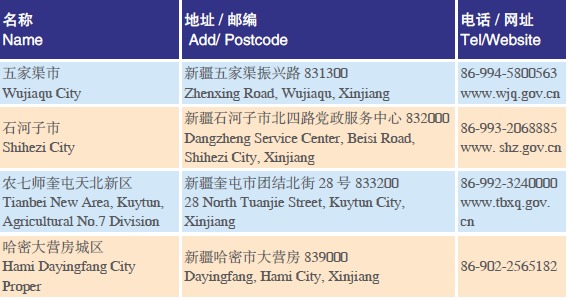
(iii) Related Organs
Entry-Exit management organs (including port management organs)
[Urumqi Customs] Entry-exit supervision and administration organ of the state established in Xinjiang, has 11 customs in Xinjiang such as Alashankou Customs, Kashi Customs, Horgos Customs, Tuergate Customs, Kunjirap Customs and Yining Customs.
[Xinjiang Entry-Exit Inspection and Quarantine Bureau] comprehensively undertakes Xinjiang entry-exit quarantine, quarantine of animals and plants, commodity inspection, appraisal, authentication and supervision management has 14 inspection and quarantine branch offices in Xinjiang.
[Xinjiang Public Security Frontier Detachment] administers 12 frontier inspection stations and 12 frontier brigades, observes national entry-exit law and regulations and implements the following responsibilities: 1. Conduct frontier inspection of entry-exit personnel and their articles of luggage, transportation tools and shipped cargo. 2. Carry out supervision over entry-exit transportation tools according to relevant national stipulations. 3. Carry out security for defined port area, maintain entry-exit order. 4. Carry out other responsibilities entrusted by competent departments and stipulated by rules and regulations.
[Port Office of Xinjiang Uygur Autonomous Region] permanent organ of the port leading group of the autonomous region, specifically responsible for port comprehensive coordination and supervision of the autonomous region.
[Port Transportation Administration Office of Xinjiang Uygur Autonomous Region] established in March 1990, a department-level organ under Communications Department of the Autonomous Region, works together with Highway Transport Administration of the Autonomous Region, has set up port transportation management station in various open ports specially responsible for port entry-exit motor transport on-spot organization, supervision and management.
Xinjiang Entry-Exit Administrative Organs
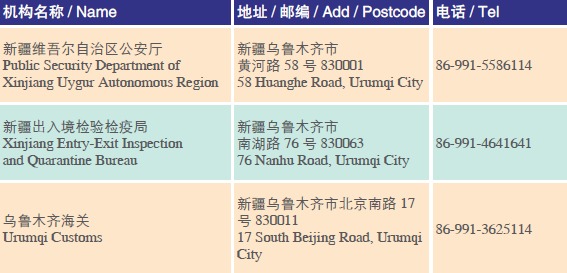

Related Administrative Organs
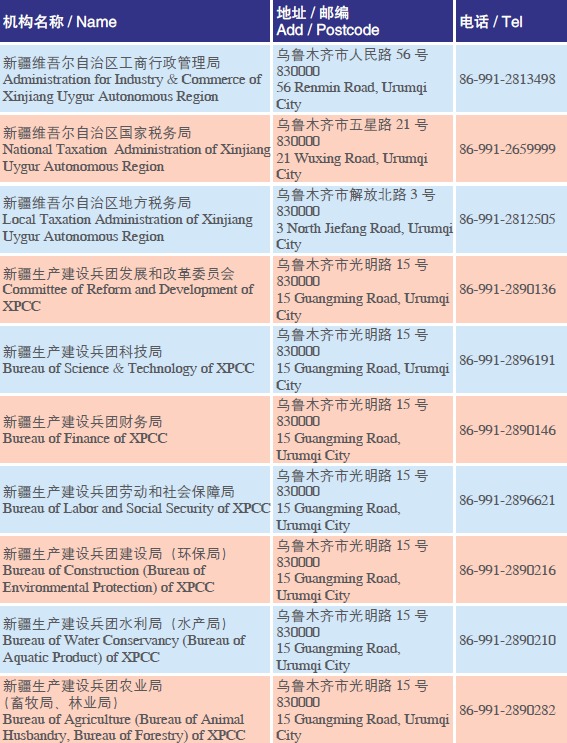
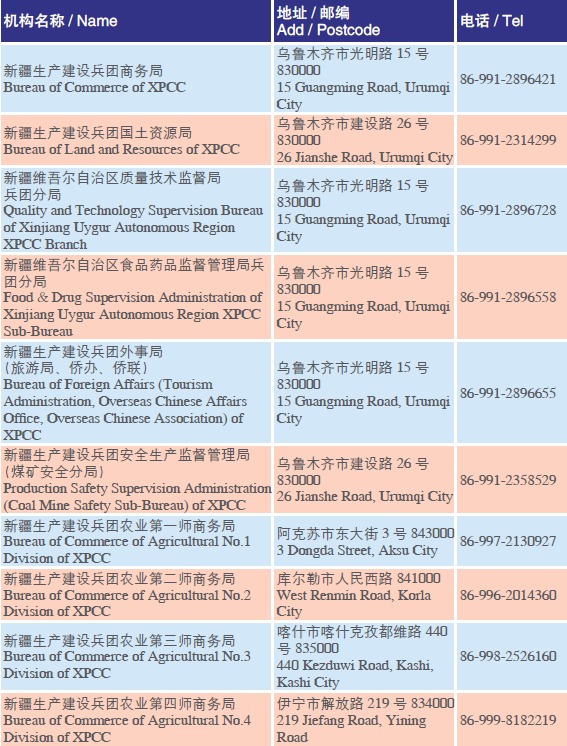
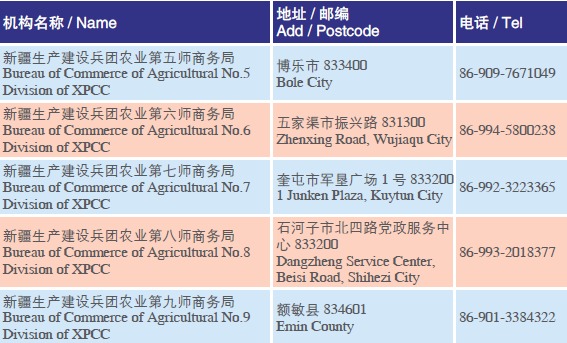
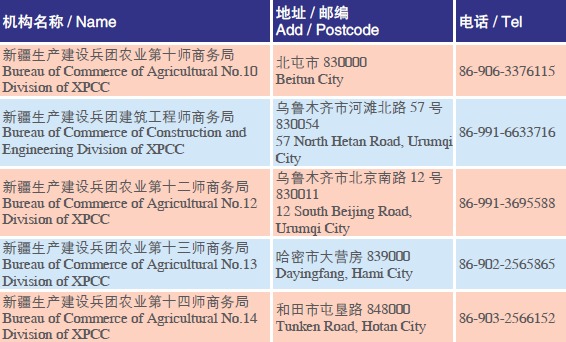
Financial and Foreign Exchange Organs
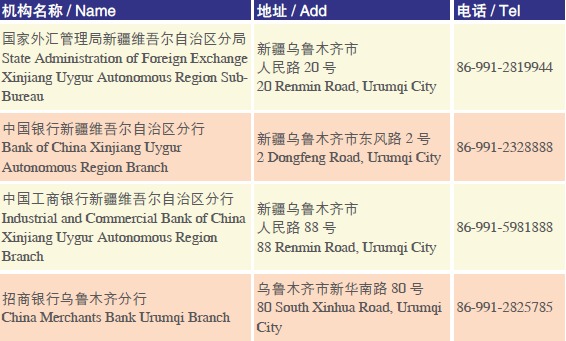
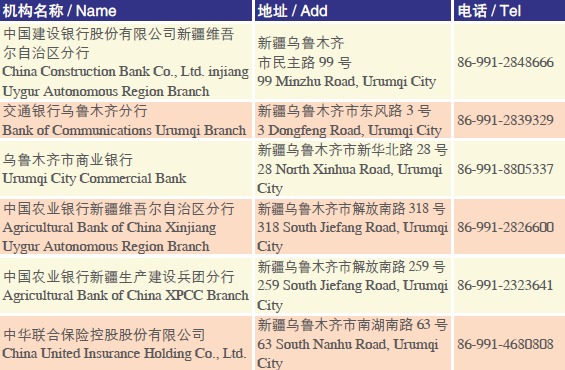
Foreign Affairs Organs

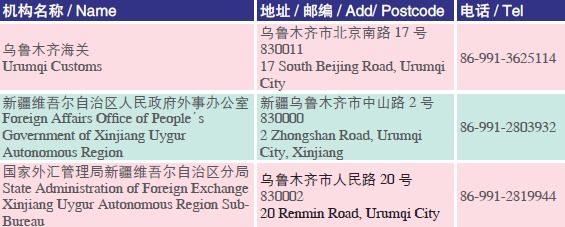
(iv) Relevant Website
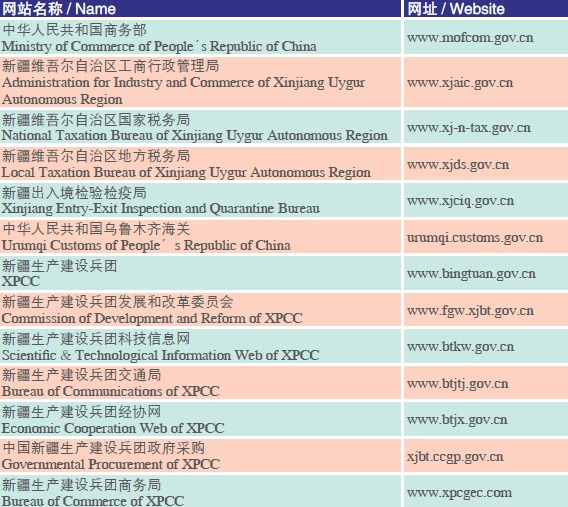
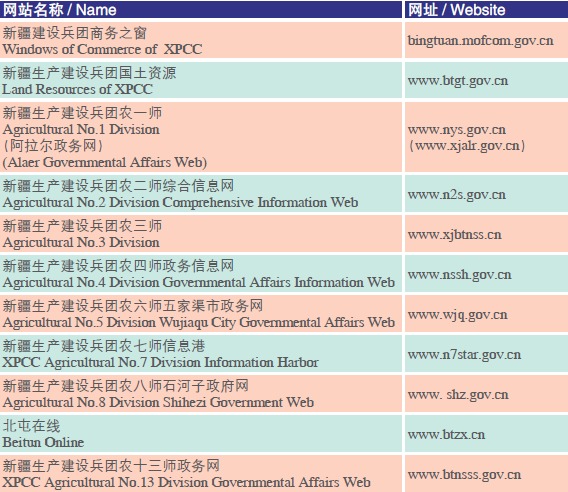
Appendix
(i) Main Hotels
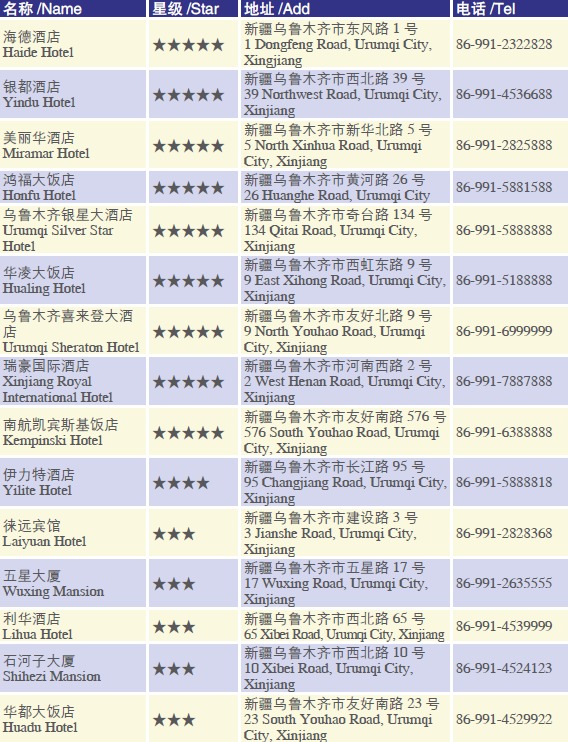
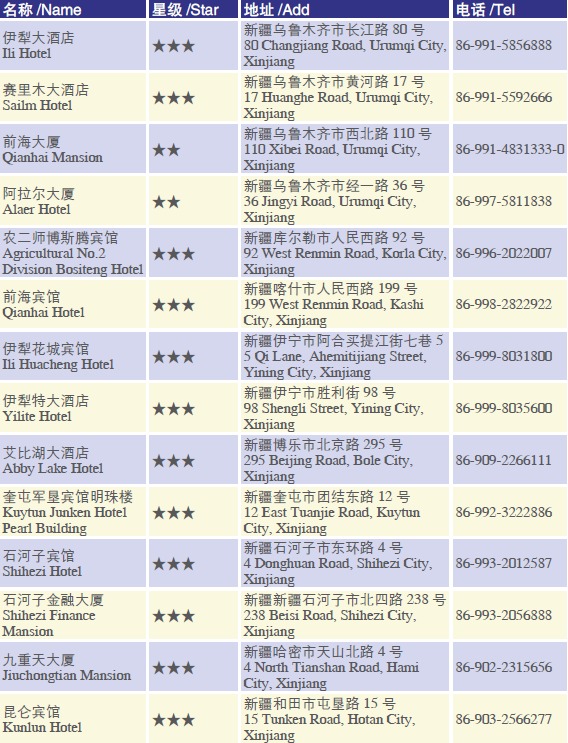
(ii) Emergency and consultation telephone


Related Articles:
Doing Business in XPCC of China: Survey
Doing Business in XPCC of China: Economy
Doing Business in XPCC of China: Investment





